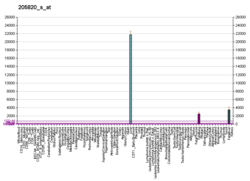Apolipoprotein C3
| ApoC-III | |||||||||
|---|---|---|---|---|---|---|---|---|---|
| Identifiers | |||||||||
| Symbol | ApoC-III | ||||||||
| Pfam | PF05778 | ||||||||
| InterPro | IPR008403 | ||||||||
|
|||||||||
| Available protein structures: | |
|---|---|
| Pfam | structures |
| PDB | RCSB PDB; PDBe; PDBj |
| PDBsum | structure summary |
n/a
n/a
n/a
n/a
n/a
Apolipoprotein C-III also known as apo-CIII is a protein that in humans is encoded by the APOC3 gene. Apo-CIII is a component of very low density lipoprotein (VLDL).
ApoCIII is a relatively small protein containing 79 amino acids that can be glycosylated at threonine-74. The most abundant glycoforms are characterized by an O-linked disaccharide galactose linked to N-acetylgalactosamine (Gal- GalNAc), further modified with up to 2 sialic acid residues. Less abundant glycoforms are characterized by more complex and fucosylated glycan moieties.
APOC3 inhibits lipoprotein lipase and hepatic lipase; it is thought to inhibit hepatic uptake of triglyceride-rich particles. The APOA1, APOC3 and APOA4 genes are closely linked in both rat and human genomes. The A-I and A-IV genes are transcribed from the same strand, while the A-1 and C-III genes are convergently transcribed. An increase in apoC-III levels induces the development of hypertriglyceridemia. Recent evidences suggest an intracellular role for Apo-CIII in promoting the assembly and secretion of triglyceride-rich VLDL particles from hepatic cells under lipid-rich conditions. However, two naturally occurring point mutations in human apoC3 coding sequence, namely Ala23Thr and Lys58Glu have been shown to abolish the intracellular assembly and secretion of triglyceride-rich VLDL particles from hepatic cells.
...
Wikipedia

